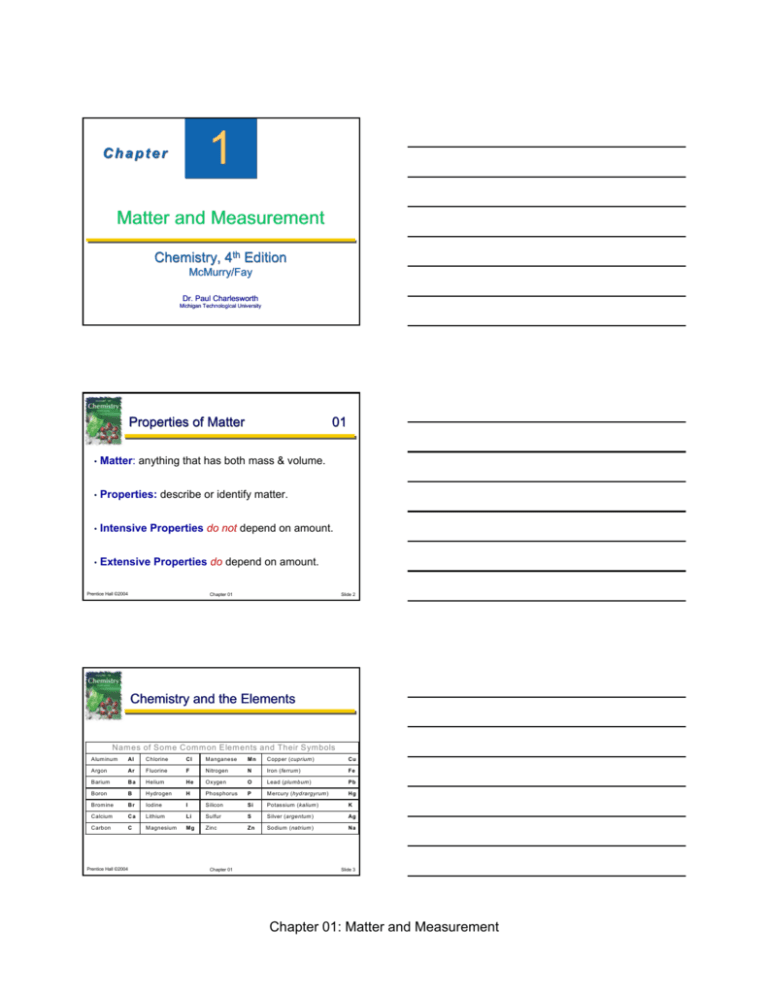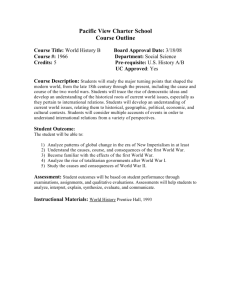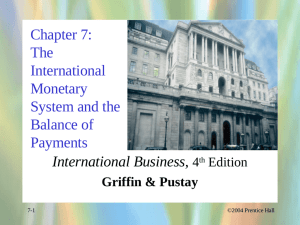Chemistry: Matter and Measurement
advertisement

1 Chapter Matter and Measurement Chemistry, 4th Edition McMurry/Fay Dr. Paul Charlesworth Michigan Technological University Properties of Matter 01 • Matter: anything that has both mass & volume. • Properties: describe or identify matter. • Intensive Properties do not depend on amount. • Extensive Properties do depend on amount. Prentice Hall ©2004 Chapter 01 Slide 2 Chemistry and the Elements Names of Som e Comm on Elements and Their Symbols Alum inum Al Chlorine Cl M anganese Mn C opper (cuprium ) Cu Argon Ar Fluorine F Nitrogen N Iron (ferrum ) Fe Barium Ba Helium He Oxygen O Lead (plum bum ) Pb Boron B Hydrogen H Phosphorus P M ercury (hydrargyrum ) Hg Brom ine Br Iodine I Silicon Si Potassium (kalium ) K C alcium Ca Lithium Li Sulfur S Silver (argentum ) Ag C arbon C M agnesium Mg Zinc Zn Sodium (natrium ) Na Prentice Hall ©2004 Chapter 01 Slide 3 Chapter 01: Matter and Measurement Elements and the Periodic Table 01 • Periods: The seven horizontal rows that group elements based on their principal quantum number. • Groups: The 18 vertical columns that group elements based on their angular momentum quantum number. Prentice Hall ©2004 Chapter 01 Slide 4 Elements and the Periodic Table 02 • • Main Groups: • s-block elements: Two groups on the left (1 & 2) • p-block elements: Six groups on the right (13–18) Transition Metal Groups: • d-block elements: Ten groups in the middle (3–12) • f-block elements: Fourteen groups between 3 & 4 are called inner transition metals. Prentice Hall ©2004 Chapter 01 Slide 5 Properties of Matter 02 • Physical Properties can be determined without changing the chemical makeup of the sample. • Some typical physical properties are: Melting Point, Boiling Point, Density, Mass, Touch, Taste, Temperature, Size, Color, Hardness, Conductivity. • Some typical physical changes are: Melting, Freezing, Boiling, Condensation, Evaporation, Dissolving, Stretching, Bending, Breaking. Prentice Hall ©2004 Chapter 01 Slide 6 Chapter 01: Matter and Measurement Properties of Matter 03 • Chemical Properties are those that do change the chemical makeup of the sample. • Some typical chemical properties are: Burning, Cooking, Rusting, Color change, Souring of milk, Ripening of fruit, Browning of apples, Taking a photograph, Digesting food. • Note: Chemical properties are actually chemical changes. Prentice Hall ©2004 Chapter 01 Slide 7 Properties of Matter PHYSICAL CHANGE PROPERTIES Prentice Hall ©2004 New form of old substance. No new substances formed. 04 CHEMICAL Old substance destroyed. New substance formed. Description by senses – List of chemical shape, color, odor, etc. changes possible. Measurable properties – density, boiling point, etc. Chapter 01 Slide 8 Properties of Matter • 05 Homogeneous matter has the same appearance, composition, and properties throughout. • Heterogeneous matter has visibly different phases which can be seen, or properties that vary through the substance. Prentice Hall ©2004 Chapter 01 Slide 9 Chapter 01: Matter and Measurement Properties of Matter • 06 Pure substances have a distinct set of physical and chemical properties and cannot be separated by physical changes. • A mixture is two or more pure substances that can be separated by physical changes. Prentice Hall ©2004 Chapter 01 Properties of Matter • Slide 10 07 An element is a pure substance with its own set of physical and chemical properties that cannot be decomposed into simpler substances. • A compound is a pure substance that can be decomposed by a chemical change into two or more pure substances. Prentice Hall ©2004 Chapter 01 Properties of Matter • Slide 11 08 Matter Classification: Matter can be subdivided into mixtures and pure substances. Prentice Hall ©2004 Chapter 01 Slide 12 Chapter 01: Matter and Measurement Properties of Matter Prentice Hall ©2004 09 Chapter 01 Slide 13 Properties of Matter 10 • Metals: Found on left side of periodic table. • Nonmetals: Found on the right side of periodic table. • Semimetals: Form a zigzag line at the boundary between metals and nonmetals. Prentice Hall ©2004 Chapter 01 Slide 14 Properties of Matter • 10 Which of the following represents a mixture? Prentice Hall ©2004 Chapter 01 Slide 15 Chapter 01: Matter and Measurement Properties of Matter • If the red spheres are oxygen and the white are hydrogen, which of the following represents (a) hydrogen peroxide, (b) hydroxide ions, and (c) a mixture of hydrogen and oxygen gas? Prentice Hall ©2004 Chapter 01 Measurement and Units • 11 Slide 16 01 Seven Fundamental SI Units of Measurement. Physical Quantity Mass Length Temperature Amount of substance Time Electric current Luminous intensity Prentice Hall ©2004 Name of Unit kilogram meter kelvin mole second ampere candela Chapter 01 Measurement and Units Prentice Hall ©2004 Chapter 01 Abbreviation kg m K mol s A cd Slide 17 02 Slide 18 Chapter 01: Matter and Measurement Measurement and Units • 03 Some Prefixes for Multiples of SI Units. Factor 1,000,000,000 = 10 9 1,000,000 = 10 6 1,000 = 10 3 100 = 102 10 = 101 0.1 = 10-1 0.01 = 10 -2 0.001 = 10 -3 0.000,001 = 10 -6 0.000,000,001 = 10 -9 0.000,000,000,001 = 10-12 Prentice Hall ©2004 Prefix giga mega kilo hecto deka deci centi milli micro nano pico Symbol G M k h da d c m µ n p Chapter 01 Slide 19 Measurement and Units • 04 Some Derived Quantities. Quantity Definition Derived Unit (Name) Area Volume Density Speed Acceleration Force Pressure Energy Length times length Area times length Mass per unit volume Distance per unit time Change in speed per unit time Mass times acceleration Force per unit area Force times distance m2 m3 kg/m3 m/s m/s2 (kg·m)/s2 (newton, N) kg/(m·s2) (pascal, Pa) (kg·m2)/s2 (joule, J) Prentice Hall ©2004 Chapter 01 Slide 20 Measurement and Units 05 • Density relates the mass of an object to its volume. • Density decreases as a substance is heated because the substance’s volume increases. • Knowing the density of a substance allows measurements in volume to be recorded in mass. Prentice Hall ©2004 Chapter 01 Slide 21 Chapter 01: Matter and Measurement Measurement and Units Prentice Hall ©2004 06 Chapter 01 Slide 22 Measurement and Units • 07 Densities of Some Common Materials. Substance Ice (0.0°C) Density (g/cm3) 0.917 Substance Human Fat Density (g/cm3) 0.94 Water (4.0°C) Gold Helium (25.0°C) Air (25.0°C) 1.0000 19.31 0.000164 0.001185 Cork Table Sugar Balsa Wood Earth 0.22–0.26 1.59 0.12 5.54 Prentice Hall ©2004 Chapter 01 Slide 23 Measurement and Units • 08 What is the density of glass (in grams per cubic centimeter) if a sample weighing 26.43 g has a volume of 12.40 cm3? • Chloroform, a substance once used as an anesthetic, has a density of 1.483 g/mL at 20°C. How many mL would you use if you needed 9.37 g? Prentice Hall ©2004 Chapter 01 Slide 24 Chapter 01: Matter and Measurement Measurement and Units • Temperature Conversions: • The Kelvin and Celsius 09 degree are essentially the same because both are one hundredth of the interval between freezing and boiling points of water. Prentice Hall ©2004 Chapter 01 Slide 25 Measurement and Units • 10 Temperature Conversions: • Celsius (°C) — Kelvin temperature conversion: Kelvin (K) = °C + 273.15 • Fahrenheit (°F) — Celsius temperature conversions: °C = 5 9 9 °F = °C + 32 5 (°F − 32) Prentice Hall ©2004 Chapter 01 Measurement and Units • Slide 26 11 Carry out the indicated temperature conversions: (a) –78°C = ? K (b) 158°C = ? °F (c) 375 K = ? °C (d) 98.6°F = ? °C (e) 98.6°F = ? K Prentice Hall ©2004 Chapter 01 Slide 27 Chapter 01: Matter and Measurement Measurement and Units • 12 Dimensional-Analysis method uses a conversion factor to express the relationship between units. Original Quantity × ConversionFactor = Equivalent Quantity Example: Express 2.50 kg in lb. ConversionFactor: 1.00 kg = 2.205 lb arranged as 2.205 lb 1.00 kg ∴ 2.50 kg × 2.205 lb = 6.00 lb (correct to 3 significant figures) 1.00 kg Prentice Hall ©2004 Chapter 01 Slide 28 Measurement and Units • 13 The volcanic explosion that destroyed Krakatau on August 17, 1883, released an estimated 4.3 cubic miles (mi3) of debris into the atmosphere. In SI units, how many cubic meters (m3) were released? Prentice Hall ©2004 Chapter 01 Slide 29 Measurement and Units • 14 How many meters are there in a marathon race (26 miles and 385 yd)? • How large, in cubic centimeters, is the volume of a red blood cell if the cell has a circular shape with a diameter of 6.0 x 10–6 m and a height of 2.0 x 10–6 m? Prentice Hall ©2004 Chapter 01 Slide 30 Chapter 01: Matter and Measurement Accuracy, Precision, and Significant Figures in Measurement 01 • Accuracy is how close to the true value a given measurement is. • Precision is how well a number of independent measurements agree with one another. Prentice Hall ©2004 Chapter 01 Slide 31 Accuracy, Precision, and Significant Figures in Measurement 02 • Significant Figures are the total number of digits in the measurement. • The results of calculations are only as reliable as the least precise measurement. • Rules exist to govern the use of significant figures after the measurements have been made. Prentice Hall ©2004 Chapter 01 Slide 32 Accuracy, Precision, and Significant Figures in Measurement 03 • Rules for Significant Figures: • Zeros in the middle of a number are significant • Zeros at the beginning of a number are not significant • Zeros at the end of a number and following a period are significant • Zeros at the end of a number and before a period may or may not be significant. Prentice Hall ©2004 Chapter 01 Slide 33 Chapter 01: Matter and Measurement Accuracy, Precision, and Significant Figures in Measurement 04 • Rules for Calculating Numbers: • During multiplication or division, the answer can’t have more sig figs than any of the original numbers. • During addition or subtraction, the answer can’t have more digits to the right of the decimal point than any of the original numbers. Prentice Hall ©2004 Chapter 01 Slide 34 Accuracy, Precision, and Significant Figures in Measurement 05 • Rules for Rounding Numbers: • If the first digit removed is less than 5 - round down • If the first digit removed is greater than 5 - round up • If the first digit removed is 5 and following numbers are nonzero - round up • If the first digit removed is 5 and following numbers are zero - round down Prentice Hall ©2004 Chapter 01 Slide 35 Accuracy, Precision, and Significant Figures in Measurement 06 • How many significant figures does each of the following measurements have? (a) 0.036653 m (b) 7.2100 x 10–3 g (c) 72,100 km (d) $25.03 Prentice Hall ©2004 Chapter 01 Slide 36 Chapter 01: Matter and Measurement Accuracy, Precision, and Significant Figures in Measurement 07 • Round off each of the following measurements. (a) 3.774499 L to four significant figures (b) 255.0974 K to three significant figures (c) 55.265 kg to four significant figures Prentice Hall ©2004 Chapter 01 Slide 37 Chapter 01: Matter and Measurement






